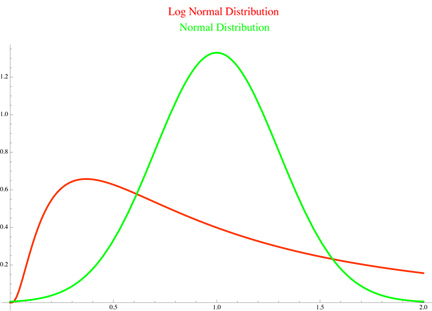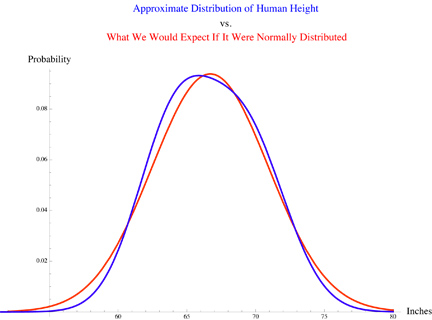Gaussians also maximize entropy for a given energy (or other conserved quadratic quantity, energy is quadratic because
From quantum mechanics, gaussians are the most “certain” wave functions. The “Heisenberg uncertainty principle” states that for any wave function
And much more generally, we know a lot about gaussians and there’s a lot of slick, easy math that works best on them. So whenever you see a “bump” a good gut reaction is to pretend that it’s a “gaussian bump” just to make the math easier. Sometimes this doesn’t work, but often it does or it points you in the right direction.
Mathematician: I’ll add a few more comments about the Gaussian distribution (also known as the normal distribution or bell curve) that the physicist didn’t explicitly touch on. First of all, while it is an extremely important distribution that arises a lot in real world applications, there are plenty of phenomenon that it does not model well. In particular, when the central limit theorem does not apply (i.e. our data points were not produced by taking a sum or average over samples drawn from more or less independent distributions) and we have no reason to believe our distribution should have maximum entropy, the normal distribution is the exception rather than the rule.
To give just one of many,
many examples where non-normality arises: when we are dealing with a product (or
geometric mean) of (essentially independent) random variables rather than a sum
of them, we should expect that the resulting distribution will be approximately
log-normal rather than normal (see image
below). As it turns out, daily returns in the stock market are generally better
modeled using a log-normal distribution rather than a normal distribution
(perhaps this is the case because the most a stock can lose in one day is -100%,
whereas the normal distribution assigns a positive probability to all real
numbers). There are, of course, tons of other distributions that arise in real
world problems that don’t look normal at all (e.g. the exponential distribution, Laplace distribution, Cauchy distribution, gamma distribution, and so on.)
Human height provides an
interesting case study, as we get distributions that are almost (but not quite)
normally distributed. The heights of males (ignoring outliers) are close to
being normal (perhaps height is the result of a sum of a number of nearly
independent factors relating to genes, health, diet, etc.). On the other hand,
the distribution of heights of people in general (i.e. both males and females
together) looks more like the sum of two normal
distributions (one for each gender), which in this case is like a slightly
skewed normal distribution with a flattened top.
I’ll end with a couple
more interesting facts about the normal distribution. In Fourier analysis we
observe that, when it has an appropriate variance, the normal distribution is
one of the eigenvectors of the Fourier transform operator. That is a fancy
way of saying that the gaussian distribution represents its own frequency
components. For instance, we have this nifty equation (relating a normal
distribution to its Fourier transform):
Note that the general equation for a (1 dimensional) Gaussian distribution (which tells us the likelihood of each value x) is
where
Another useful property
to take note of relates to solving maximum likelihood problems (where we are
looking for the parameters that make some data set as likely as possible). We
generally end up solving these problems by trying to maximize something related
to the log of the probability distribution under consideration. If we use a
normal distribution, this takes the unusually simple form
which is often nice
enough to allow for solutions that can be calculated exactly by hand. In
particular, the fact that this function is quadratic in x makes it especially
convenient, which is one reason that the Gaussian is commonly chosen in
statistical modeling. In fact, the incredibly popular ordinary least squares regression technique
can be thought of as finding the most likely line (or plane, or hyperplane) to
fit a dataset, under the assumption that the data was generated by a linear
equation with additive gaussian noise.


댓글 없음:
댓글 쓰기